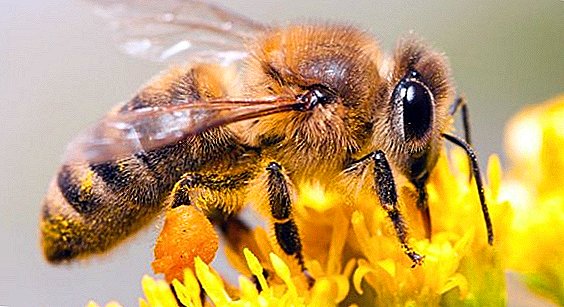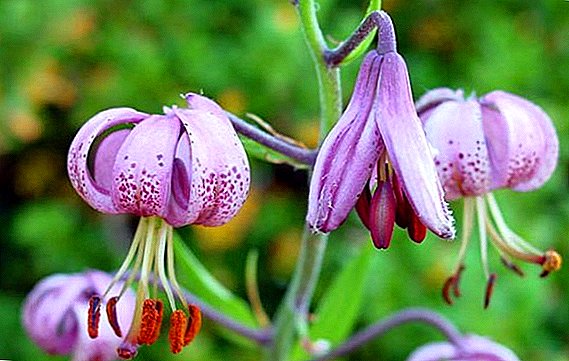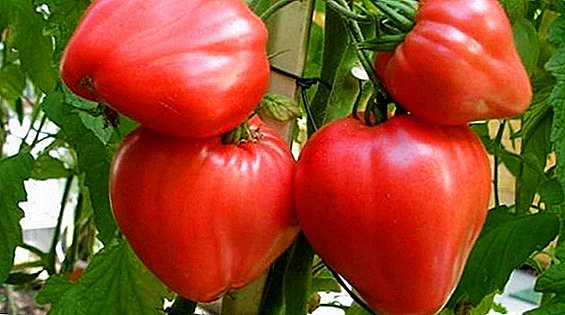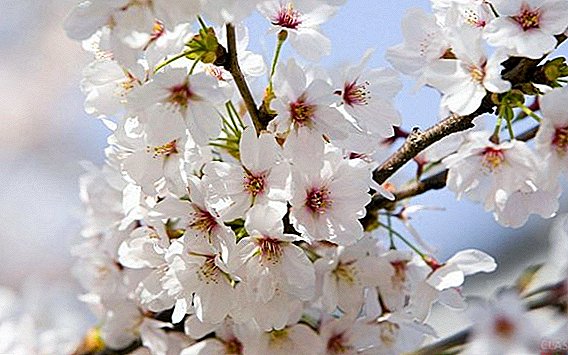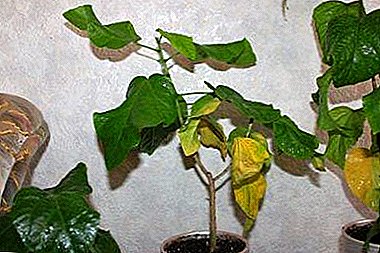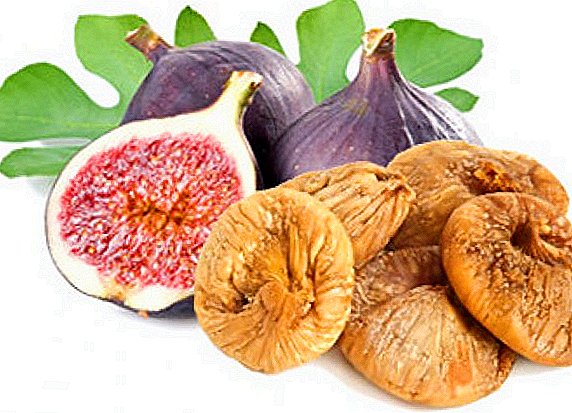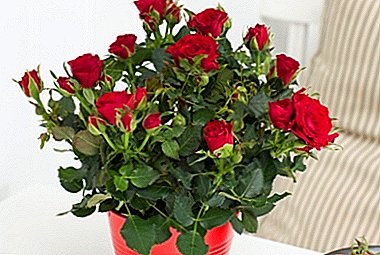
About her singing poets of all ages.
There is nothing more tender and beautiful in the world
Than this bundle of scarlet petals,
Opened with a fragrant bowl ...
I begin this article with a excerpt from S. Marshak's poem because it is about a flower that delights everyone without exception. Queen of all colors. The symbol of perfection ... What kind of epithets do not award a rose to admirers of its beauty.
Not surprisingly, many home plant lovers dream to enjoy the flowering and aroma of this miracle of nature all year round. However, it is not so easy to grow a rose at home. Caring for it is significantly different from the care of other indoor plants. And if you decide on this experience for the first time, then this is the first pitfall ...
Flower shop
 There are many specially bred varieties that can bloom all year round.. They have a compact form, various sizes, colors, terry and fullness of the bud, and often fragrance. But ... most of the flowering flowered bushes are sold as a “live bouquet”, which will live for one or two months in indoor conditions.
There are many specially bred varieties that can bloom all year round.. They have a compact form, various sizes, colors, terry and fullness of the bud, and often fragrance. But ... most of the flowering flowered bushes are sold as a “live bouquet”, which will live for one or two months in indoor conditions.
The fact is that firms engaged in the cultivation of container plants think about good profits after the sale, and not about the long life of the flower. Therefore, plants often overfeed with any chemistry, which greatly harms their immunity and supersaturate the soil with excess salts. A few bushes fit in a small pot for pomp. And so, while they are still nice and fresh, young beauties change the conditions of the store to the conditions of apartments that are far from ideal for them.
The rehabilitation period of the purchased plant
At home it would be good to recreate for the chosen one the conditions in which she was before: air temperature, humidity, irrigation mode, location in the shade or in a bright place ... Similarity of conditions of detention will help the new girl to quickly adapt. Later it is necessary to provide for her the right care.
The rehabilitation period will last 2-3 weeks. And this period will be for the rose the most difficult. So complicated that she can throw off not only all the buds and flowers, but even the leaves.
After adaptation, the rosette will start growing again, and with proper care it will bloom! It will happen in about 1-1.5 months. Bought a rose in a pot and do not know how to care for her? Below is a guide to care.
What care is needed at home?
 What to do after buying a flower in a pot? Care for a rose start immediately after purchase. After freeing the packaging film, carefully inspect it. Cut dry twigs and blackened shoots. Experienced growers are also advised to get rid of buds and flowers, since stimulated flowering greatly weakens the rosette.
What to do after buying a flower in a pot? Care for a rose start immediately after purchase. After freeing the packaging film, carefully inspect it. Cut dry twigs and blackened shoots. Experienced growers are also advised to get rid of buds and flowers, since stimulated flowering greatly weakens the rosette.
Even if no pests are found, the plant should be washed under a warm shower. This should be done for the prevention of spider mites. The treatment with antifungal medication (Fitosporin) will not be superfluous.
Where to put?
Indoor roses are light-requiring and it is desirable to place them on the southern and southeast windowswhile avoiding direct sunlight on the flowers. Ideally - light from 16 to 18 hours per day. If due to residential or climatic conditions the lighting is not enough, you can use fluorescent lamps. Good summer flowers will be on the balcony. You can take them to the dacha in the pots and place them in a flower garden, in a shaded place.
So, in summer, the rose is actively developing, it must be regularly watered, timely fed, sprayed. In autumn, when the air temperature drops, the growth rate of the rose decreases. Therefore, feeding plants stop, and watering is reduced.
In winter, for the one that so long pleased you with its flowering, it is time to rest. It's time to correct its growth. Each twig is cut with a sharp knife, no more than five buds remain on each twig. Now the flower can be removed in a dark and cool, about 10 ° C, place. In the spring, fresh leaves will appear on the rested rose. and it will start growing again.
Rules for the care of a flower in a pot
Watering
Proper watering is very important for the successful cultivation of indoor roses. Watering, as they say in many manuals, must be plentiful, but ... not often. The soil in the pot must have time to dry. In the summer it is necessary to follow it especially carefully. The plant may need watering up to two times a day - in the morning and in the evening. Until complete saturation. Well, if the water is separated and at room temperature.
The best way to check whether it is necessary to water a rose, to the touch. If the ground is wet - wait with watering.
The fact that with irrigation overdosed say white scurf on the top layer of the earth (mold) and the unpleasant smell from the pot. The roses began to rot the roots and it perishes. In winter, when the plant "sleeps", watering is reduced to a minimum.
Top dressing
 It is necessary to feed a rose more often than other plants.. Flowering takes a lot of power from a small bush. It is logical that this Cinderella should be fertilized during the period of growth and flowering.
It is necessary to feed a rose more often than other plants.. Flowering takes a lot of power from a small bush. It is logical that this Cinderella should be fertilized during the period of growth and flowering.
It is good, if top dressing by mineral fertilizers will alternate with organic top dressing. (From natural fertilizers for roses, the best is a mullein solution, it can be purchased at a flower shop).
For spraying - solutions of drugs like Epin. Start feeding immediately - one month after transplantation, then every 2 weeks and with the appearance of the ovary - once a week. In the evening, after watering. In the autumn, watering is reduced, and feeding is less common. In the winter - without top dressing.
How to transplant?
Florists do not have a single opinion: when to repot a flower? Some believe that immediately after the acquisition, others advise giving a rose 2-3 weeks for additional flowering and adaptation. As the heroine herself shows this pink story, her condition. Is the flower not infected with parasites, do not the roots climb from the holes of the cramped container, do not smell like rot from the soil ... Everyone agrees on one thing: The most favorable time for transplanting is early spring or late summer.on the growing moon.
So, we make a powerful pruning of the flower before a transplant and prepare everything necessary. The pot should be larger than the old by 2-3 cm in diameter, the height of the pot is equal to the height of the plant. Preference - ceramic pot with glazing. Soil easier to take in a flower shop: for planting roses, no other. Suitable for drainage claydite, shards, foam.
Before planting the old pot is immersed in a container with water so that the earth is soaked. When you take a rose, just turn it over, letting the plant pass between your fingers. The lump with roots will come out easily and intact. If there were several bushes in the container, it is better to separate them and transplant them into different pots. So that the flowers were not crowded and they did not shade each other. Rotten and dried roots carefully remove.
At the bottom of the new pot - drainage (2-3 cm), on top - a clod of earth with roots (2 cm to the top) and fill the edges along the edges. Seal by shaking the pot, without tamping. If the ground settles after watering, sprinkle. Watering on the day of transplantation is not necessary in a day. But spray - necessarily, even twice.
Possible problems

- Rose - a tasty morsel for many pests. Most often annoying spider mite. The appearance of this parasite is signaled by dots on the leaves, as if by a needle, a web appears on the processes. The leaves turn yellow and fall off.
How to save a rose growing in a pot? From the tick, the most popular drug is Fitoverm, the plant is sprayed with a solution and the soil is soaked. The procedure is repeated 2-3 times with an interval of 7-10 days. This trouble appears due to the lack of moisture, so frequent bathing is good for prevention.
- Buds and young shoots suddenly began to deform, twist and dry out, look closely. Saw small insects? This is aphid. Do not hesitate, treat sweeten with a soap solution. Chemistry - drugs containing karbofos.
And here's another funny tool: if the aphids are a bit, you can bring in and plant a few ladybirds on the bush, wishing the last to enjoy your meal.
- The leaves were covered with dark spots. Began to turn yellow and fall off. Rose has a fungal disease. It happens from excessive moisture. For example: under the packaging film in the store, when water gets on the leaves when watering (watering should be the ground, and not the whole plant).
Infected leaves should be removed and treated using fungicidal agents. Above was mentioned Fitosporin.
- If the plant has been subjected to sudden changes in temperature (cold nights after warm days), powdery mildew may appear. Leaves and buds are as if powdered with white powder. Treatment: destroy the damaged parts of the plant and again - fungicidal drugs.
- Leaves have yellow streaks or spots. Perhaps this is bacterial cancer. The roots and the lower part of the flower are rotting. Rose will have to dig and destroy, as there are no chemical means of struggle. Infected land is no longer used.
- Rosette saddened: the buds wither, the leaves dry and fall off - all this may indicate an error of care. If the shoots dry out - short and dry air. We reanimate urgently! It is necessary to remove dried branches up to 3-4 cm from the trunk. Pour and place the pot with a rose in a pan filled with water. Or we build a greenhouse from a plastic bag.
Worse, if the sad rose twigs do not dry, and rot. This is overflow. And salvation is a transfer to a new land with the removal of rotten roots.
Changing habitat conditions, cold and hard water for irrigation, overheating in summer, dry air in winter, spraying and watering in a cold room, cramped pot, untidy wilted flowers ... Learn to "hear" and understand your rose. And she will thank you for sure!
... So in our house goes year after year,
And in the house a beautiful rose grows.
She is not a flower, but a wonderful child,
She smiles even asleep
She is good as all the roses in the garden
That only blooms every month of the year!


